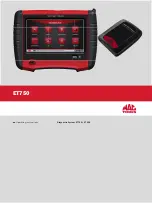
ED01_REV03-2021 IFU HEAD IMMOBILIZER-ENG
8 - 12
have no experience, skill and expertise. Normally the number of rescuers for these operations is two. Below are the
operations necessary for the immobilization of the head:
1.
Always warn a conscious patient about what we are doing and calm them down as much as possible
2.
One rescuer manually stabilizes the patient's head and neck (to which the cervical collar had previously been
applied correctly). These instructions do not deal with the application of the collar that refers to other
manufacturers and user manuals
3.
The second rescuer applies a sterile sheet on the head immobilizer (both models) that will serve to isolate the
head and the skin from the device itself and avoid any allergies or irritations. Then apply the device by slightly
raising the patient's head and insert the head immobilizer (applies to both the WIND and OB version)
4.
Make sure the base is centered relative to the patient's head
5.
Now if you are using the WIND head immobilizer it is enough to raise the two wings and apply the two chin
guards respectively to fix the chin and forehead. In the OB head immobilizer, it is enough instead to apply the
two wedges on the Velcro of the base, taking care not to tighten the head excessively (the wedges must be
adherent)
BIOCOMPATIBILITY
Sterile sheet placed between the head immobilizer and the patient's head is necessary to
prevent skin irritation and reactivity due to the patient's direct contact with PVC (WIND) or
vinyl paint applied to the surface of the device (OB). It also establishes a thermal barrier in
case the temperature of the device is very high or very low
6.
Always check the patient’s condition during all immobilization operations and during
transport to the hospital or nearby rescue center. The photo on the side illustrates the
correct use of the immobilizer WIND applied to a patient already equipped with a cervical
collar
8.
REUSE OF BOSCAROL HEAD IMMOBILIZER
After each use it is necessary to proceed with the cleaning and disinfection of the medical device. These operations are
of greater importance if the patient's pathological condition is not known and direct contamination maybe present.
The user must always take protective measures and means to protect his or her safety.
OB and WIND head immobilizers must be washed with water not exceeding 40°C of temperature. Never use metal or
very hard abrasive brushes that could ruin the fabric and coating of PVC.
Pressure washer
Do not use high pressure washers that could damage the surface layers of the head immobilizer
and damage Velcro and polyethylene flaps
Attention
Do not cut or change the structure and shape of Boscarol head immobilizer so as not to damage
it irreparably
Remove the sheet that was placed between the patient's head and the device and discard it. After separated the
wedges (by removing from the Velcro strap), the chin guards and the fasten belts of the OB head immobilizer (the
WIND head immobilizer is composed of a single piece) clean and remove with the use of water all the substances
present. If necessary, use a non-abrasive sponge to remove any fouling. Before proceeding with disinfection remove
any traces of blood and/or organic left from the patient. Disinfect the head immobilizer (the entire surface) with
substances suitable for that purpose (do a test on one side of the device to check does not damage). Do not use bleach
and iron brushes, steel wool and blades of any kind to eliminate fouling. Colored disinfectants could irreparably stain
the surfaces of the device itself. Before storing the device, make sure it is completely dry to avoid mold forming on the
Sterile sheet
Head immobilizer
Head of the patient






























